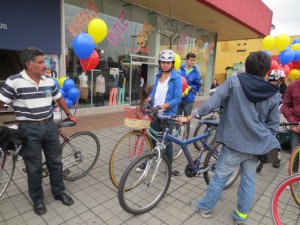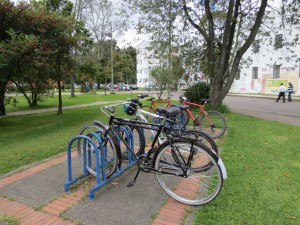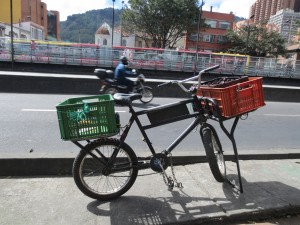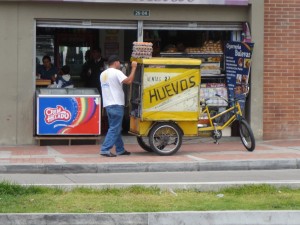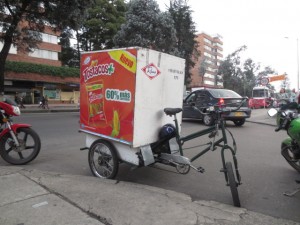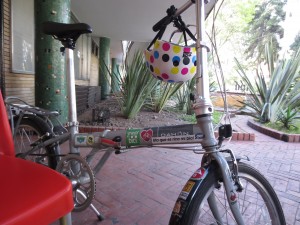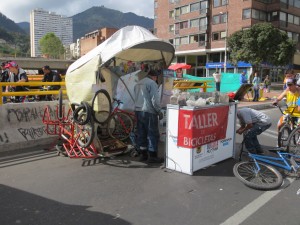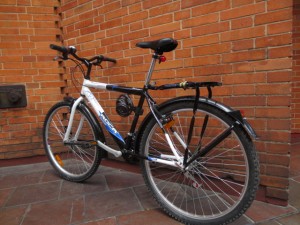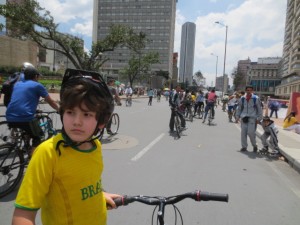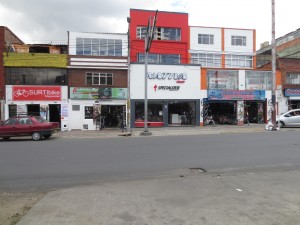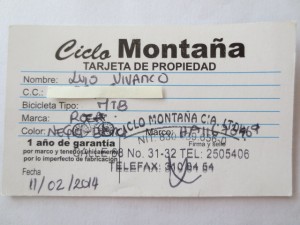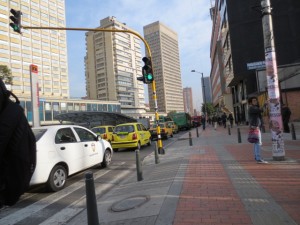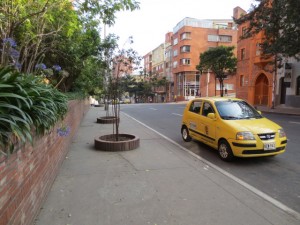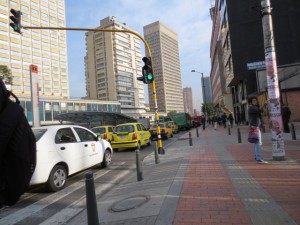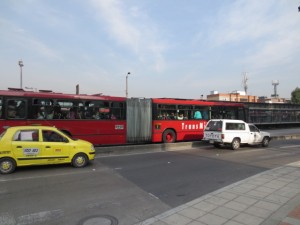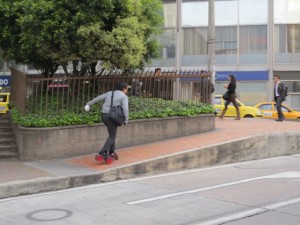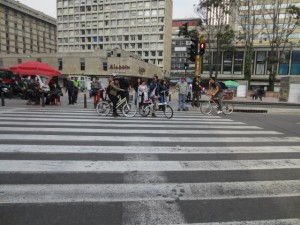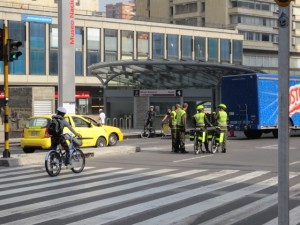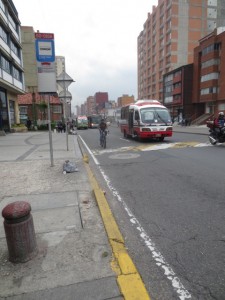 I live in the center of Bogotá and circulate between here and the north of the city everyday. Conditions for cyclists are quite variable elsewhere in this enormous city, but these are some of the things I’ve learned in my last two months about urban cycling in the centro:
I live in the center of Bogotá and circulate between here and the north of the city everyday. Conditions for cyclists are quite variable elsewhere in this enormous city, but these are some of the things I’ve learned in my last two months about urban cycling in the centro:
1. Have no fear. It is necessary to have a lot of confidence in your abilities as a bicycle rider and to have no fear if you are going out into Bogotá’s chaotic traffic. Apparent risks and threats are myriad, from hostile car drivers and unpredictable taxis and buses that can squash you, to finding yourself traveling through a dangerous neighborhood. Many Bogotanos consider riding a bike too fearful in these circumstances and won’t do it. But…
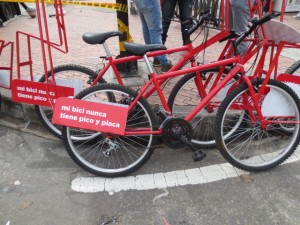 2. For practically all trips up to 5 or 6 miles, riding a bike is faster than getting places in a private car, taxi, bus, or Transmilenio. I hear it all the time from my informants and I experience it myself almost daily. One of my usual daily trips is 45-50 minutes on bus and 25 minutes on a bike. During the trajectory of a bus ride I can often keep track of cyclists over many blocks and the norm is for them to make out better than us. And riding a bike is predictably quick, while traffic conditions, which are often terrible, can really delay you in a car or bus. Part of the reason for this is that…
2. For practically all trips up to 5 or 6 miles, riding a bike is faster than getting places in a private car, taxi, bus, or Transmilenio. I hear it all the time from my informants and I experience it myself almost daily. One of my usual daily trips is 45-50 minutes on bus and 25 minutes on a bike. During the trajectory of a bus ride I can often keep track of cyclists over many blocks and the norm is for them to make out better than us. And riding a bike is predictably quick, while traffic conditions, which are often terrible, can really delay you in a car or bus. Part of the reason for this is that…
3. Riding a bike in the city is a liberating and creative practice. As a cyclist you have more options to use street space than do drivers of cars and buses, and cyclists here creatively use the spaces available to them—streets, spaces between motorized vehicles, sidewalks (it is legal to ride on them), and Ciclorutas—to move quickly. If you are a confident rider you have a lot of liberty to be creative—the police are indifferent and other road users assume that you’re just like them: out to get ahead anyway you can so they’re pretty tolerant of your moves. Connected to this issue is the fact that…
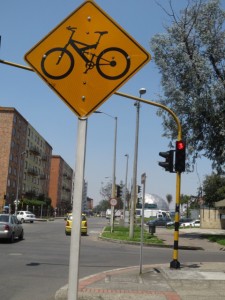 4. Traffic signs are untrustworthy and intersections are negotiable. Different intersections often have individual norms that diverge from what the signs say, if there are any signs, that is. It might say “Ceda el Paso” (Yield) but then don’t see much yielding going on…You have to quickly assess the invisible norms and the contingent flow at that moment in order to make a decision. And when you’re stopped at an intersection and there is no cross traffic, some cyclists will wait for the lights but most zip right through. You also have to be creative because…
4. Traffic signs are untrustworthy and intersections are negotiable. Different intersections often have individual norms that diverge from what the signs say, if there are any signs, that is. It might say “Ceda el Paso” (Yield) but then don’t see much yielding going on…You have to quickly assess the invisible norms and the contingent flow at that moment in order to make a decision. And when you’re stopped at an intersection and there is no cross traffic, some cyclists will wait for the lights but most zip right through. You also have to be creative because…
5. “If you ride in a straight line, you’re in trouble.” One of my informants made this observation in response to our hearing a story from a third cyclist about riding on the Cicloruta and getting hit by a taxi while he was crossing an intersection. There are myriad reasons for it: cars pulling in front of you with no warning, holes in the pavement, pedestrians stepping in your way, trash, etc. But you also have to beware because…
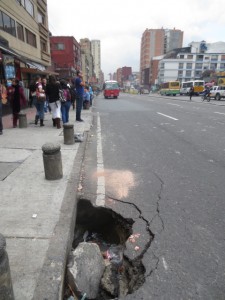 6. If you swerve a lot you’re also in trouble. You need to have a keen sense of space behind, to the side, and in front of you if and when you swerve, and your movement has to be pretty precise. Someone or something might be in the space you want to move into—other cyclists, pedestrians, etc.—and chances are you’ve not been given any audible warning since aside from ubiquitous honking, there’s not a lot of communication between travelers.
6. If you swerve a lot you’re also in trouble. You need to have a keen sense of space behind, to the side, and in front of you if and when you swerve, and your movement has to be pretty precise. Someone or something might be in the space you want to move into—other cyclists, pedestrians, etc.—and chances are you’ve not been given any audible warning since aside from ubiquitous honking, there’s not a lot of communication between travelers.
7. You have to really trust your bike…even if you don’t trust it. Bogotá streets have steep curbs, cracks and holes in the pavement, and other physical irregularities. A bike takes a beating, and you have to trust it will all hold together. Screws loosen, tires get pinched, etc. so you always have to be monitoring the status of your bike. If there is a problem, assistance can be scarce, or worse, it can happen when you are passing through a dangerous area. I really have to trust my cheap bicycle to work, even though I don’t really trust it much, being accustomed to much higher quality urban bicycles at home.
8. Most people are indifferent toward your well-being as a cyclist. Most pedestrians and drivers of motorized vehicles, it seems, would just as soon run you over or get in your way, and let you get out of theirs. They are indifferent to the fact that you’re there. Courtesy is rare, and everyone assumes they’re out for themselves.
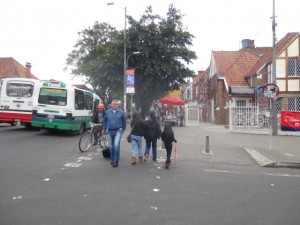 9. Riding the Cicloruta in some areas can be like playing Frogger with pedestrians. There is an implicit transportation hierarchy in this city, with motorized vehicles on top, bicycles a distant second, and pedestrians even lower. One reflection of this inequality is that when the city built some of the earliest Ciclorutas, they put them on sidewalks, taking space away from pedestrians. Whether it is lack of space, resentment, or that indifference mentioned above, pedestrians are regularly walking in and crossing the Cicloruta without looking. Riding a a Cicloruta can sometimes be like the old video game Frogger in which you’re dodging one person after another to avoid hitting them.
9. Riding the Cicloruta in some areas can be like playing Frogger with pedestrians. There is an implicit transportation hierarchy in this city, with motorized vehicles on top, bicycles a distant second, and pedestrians even lower. One reflection of this inequality is that when the city built some of the earliest Ciclorutas, they put them on sidewalks, taking space away from pedestrians. Whether it is lack of space, resentment, or that indifference mentioned above, pedestrians are regularly walking in and crossing the Cicloruta without looking. Riding a a Cicloruta can sometimes be like the old video game Frogger in which you’re dodging one person after another to avoid hitting them.
10. Riding on the street with automobiles and bus traffic is much faster than riding the Cicloruta. Many of the most committed urban cyclists avoid the Ciclorutas because it is quicker and more efficient to stick with automobile traffic. On the Cicloruta you may have to stop to wait for cross-traffic or turning vehicles at every intesection and hassle with pedestrians. Although some intersections have ramps for you down to the street level (sidewalks are about 18 inches up), chances are there isn’t one, and you have to jump up and down off the sidewalks onto the street. Without all this stop and go, bucking and weaving, and up and down, you can get places a lot more quickly.
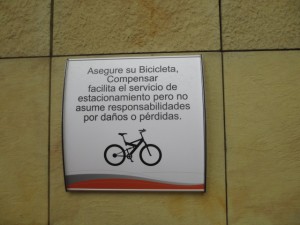 11. Bike parking is scarce, substandard, and unreliable. This is a major concern of bicycle activists in the city right now and they are fighting for change on this issue. Bike racks are scarce and when available often packed with other bikes; many public parking lots don’t allow bike parking; and leaving your bike out for long, even if it’s locked, is generally considered risky given the number of bike thefts here. Experienced cyclists generally know where they can park, but if there’s nothing available, will cajole or negotiate their bikes into the store, café, or house.
11. Bike parking is scarce, substandard, and unreliable. This is a major concern of bicycle activists in the city right now and they are fighting for change on this issue. Bike racks are scarce and when available often packed with other bikes; many public parking lots don’t allow bike parking; and leaving your bike out for long, even if it’s locked, is generally considered risky given the number of bike thefts here. Experienced cyclists generally know where they can park, but if there’s nothing available, will cajole or negotiate their bikes into the store, café, or house.
12. Know your bike’s serial number. Where there is bike parking and it is inside the building or campus of a government institution, university, or corporation that has security guards at the front entrance, you have to register your bike when you enter and check it out when you leave. It can be a cumbersome process as the guard fills out a ledger or two slips of paper (one for him, one for you) with your name, ID number, characteristics of the bicycle…and the last four digits of the bike’s serial number. It’s helpful if you have all that info memorized. And don’t lose that little slip of paper, or getting your bike out when you leave can be a problem.
13. At a traffic signal, take your spot at the front of the other traffic. When arriving at an intersection with a red signal light, cyclists don’t line up behind the cars, they filter their way—weaving through stacked up cars and buses—to take their spot at the front. As long as you don’t bump any of the cars with your handlebars, nobody minds.
14. At a traffic signal, take advantage of the flashing yellow light indicating a green light is coming. Following up from #13, here as in many Latin American countries, the yellow light on a traffic signal flashes briefly right before the signal turns from red to green. As a cyclist at the front of the line, this is your head-start. But beware of cross-traffic running the light.
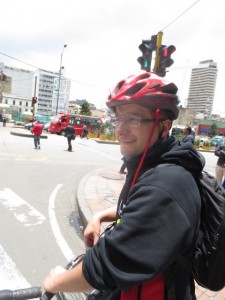 15. Get some accessories, especially a whistle. Elite urban cyclists here have whistles hanging on their helmets that make very sharp sounds, and they use them liberally and loudly to warn car drivers and pedestrians to stay out of their way. It is also somewhat common to see cyclists wearing face masks (everything from a bandana to full-on nuclear meltdown type breathing masks) to filter out noxious bus fumes.
15. Get some accessories, especially a whistle. Elite urban cyclists here have whistles hanging on their helmets that make very sharp sounds, and they use them liberally and loudly to warn car drivers and pedestrians to stay out of their way. It is also somewhat common to see cyclists wearing face masks (everything from a bandana to full-on nuclear meltdown type breathing masks) to filter out noxious bus fumes.
16. You can squeeze between a stopped bus and a sidewalk…but watch for dismounting passengers. Since the buses called colectivos stop and go all the time, they regularly and unexpectedly swerve to the sidewalks all the time. If you’re riding on the right side of the road you have to make some quick decisions about what to do. I’ve observed and even myself squeezed between the bus and the sidewalk, but you have to time it superbly as passengers dismount right in front of you.
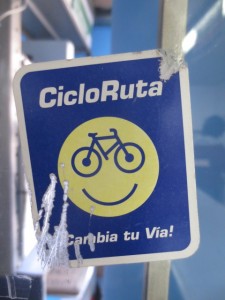 17. You mix it up with electric bicycles, motorized bicycles, mopeds, and even sometimes motorcycles on the Cicloruta. Hybrid bicycles are relatively common, and motorcycles are ubiquitous. They all move much faster than you can pedal. And they show up on the Ciclorutas, meaning you have to keep your eye out for them lest you swerve into one as it speeds up from behind you.
17. You mix it up with electric bicycles, motorized bicycles, mopeds, and even sometimes motorcycles on the Cicloruta. Hybrid bicycles are relatively common, and motorcycles are ubiquitous. They all move much faster than you can pedal. And they show up on the Ciclorutas, meaning you have to keep your eye out for them lest you swerve into one as it speeds up from behind you.
18. Many experienced urban cyclists claim to have developed claustrophobia of public buses. Experienced and committed urban cyclists have often reported to me that after gaining a sense of confidence and adpating to traffic conditions on a bicycle, they have liberated themselves from the drudgery of riding public buses—which is the by far the largest mode share here. They say that riding a bus is constricting and claustrophobic. They don’t like to be crammed in like sardines and they feel they’ve lost one of the things they most prize as cyclists, their freedom.
